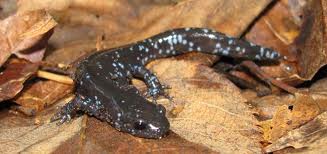BURLINGTON, ON Burlington, Ont., March 12, 2013 — The slimy little creature that brought a halt to the opening of a second quarry on the Escarpment is expected to begin his migration to his breeding ponds between the middle of March and the middle of April. The city of Burlington shuts down parts of King Road while the little creature slithers across the road.

Details on the King Road closure. Dark line at the base of the mountain brow indicates where traffic cannot use the road for about a month.
King Road will close from the base of the Niagara Escarpment to Mountain Brow Road, March 18 to April 8 to allow the endangered Jefferson salamander safe passage during its annual migration to lay eggs.
In Canada, the Jefferson salamander is found in Southern Ontario in a few small pockets of deciduous forest; mostly along the Niagara Escarpment. Burlington is home to one of those small pockets.
Jefferson salamanders spend the winter underground, then seek temporary ponds formed by spring run-off, sometimes crossing King Road to do so. They lay their eggs in clumps attached to underwater vegetation. By midsummer, the larvae lose their gills and leave the pond and head into the surrounding forest.
The Jefferson salamander is a protected species and is a nationally and provincially Endangered Species at Risk.
Conservation Halton is committed to preserving native biodiversity and protecting species at risk through activities such as protection of natural heritage systems, the creation of wildlife corridors, and increased public awareness through education, outreach and partnerships with local organizations.
In 2012, the city closed the same section of road completely for a three-week period. “The closure was a success last year. There is evidence to make the city and our partners believe that the Jefferson salamanders were able to travel safely across the roadways,” said Bruce Zvaniga, director of transportation services.
“The reaction was positive towards the road closure last year and shows how the community will support steps to protect the local environment,” said Rick Craven, Ward 2 councillor.
“Conservation Halton commends the City of Burlington for once again undertaking a full closure of King Road. It is also encouraging to note the support of area residents who are keen to help ensure the long-term survival of the Jefferson salamander, by taking steps to protect its habitat,” said Ken Phillips, Conservation Halton CAO. “Our studies showed that last year’s road closure was a tremendous success allowing the salamanders to safely traverse the roadway on their way to the breeding ponds.”
Adult salamanders migrate to their breeding ponds in mid-March or early April during wet rainy nights. They show strong fidelity to their birth pond and can be very determined to reach it.
The salamander played a much larger role in the community effort to stop the opening of a second quarry on the Escarpment. Burlington heroine Sarah Harmer was a significant part of that effort when she testified at the Joint Board hearings that made the decision not to issue an additional mining permit.
Harmer saw her first salamander in the basement of her home on an Escarpment side road when she was a young girl; little did she know then of the career she would have in the future and the role that slimy little guy would have on the community she was raised in.
PERL, Protect Escarpment and Rural Lands, of which Sarah and her mother Isabelle were a large part, went on to oppose the quarry application and saw the Tribunal that heard the arguments come down in favour of the environment citing the endangered status of the Jefferson Salamander.
The legal costs for the city of Burlington were $2.1 million. PERL is still believed to have a significant legal debt. Time for a big fund-raiser; Sarah get the guitar.





















I liked your nice article about us Jefferson salamanders in Burlington. We really don’t want so much attention, but thank you. Three things need clearing up, though.
You described us as slimy. We don’t particularly care for that description. Would you? We really prefer the terms slim, slick, sleek, slender, slinky, or if you must, slippery. Anything else seems slanderous.
You also said we slither. Snakes slither. We don’t. We walk on our legs like any self-respecting quadriped.
Finally, you mentioned that Burlington has one small pocket of us Ambystoma jeffersonianum. I live in one near King Road. But I have relatives who live further north on Mt. Nemo. I think that makes two pockets. And they seem big to me, but then I’m only 6 inches long. I guess it’s relative.
Your friend, Jeff Salamander
By the way, you can follow me on Twitter. I’m @Jeff_Salamander
The story of the Jefferson Salamander migration ritual posted in the Burlington Online Newspaper on March 12 2013 was truly inspiring! This story is unique and extraordinary it makes me feel happy to be a citizen of Halton. The commitment to this small creature and its rituals for reproduction is one to be admired for people throughout the Halton area. The fact that the populated region of Burlington accepts the importance of this small creature enough to close down a large section of a very busy highway for a span of twenty two days in its name is simply incredible. The attention that Conservation Halton is paying to the Jefferson Salamander shows its yearning to preserve this small creature as well as protect local diversity. The Jefferson Salamander is classified as an Endangered Species at Risk and therefore demands the community protection it is receiving. I hope that the lengths to which the city of Burlington is going to protect the Jefferson Salamander really pay off in the future. Doing this step may seem small but it protects the biodiversity of the region and could potentially remove the amphibian from a state of Endangered Species at risk.
Kaitlyn Bell, Acadia University Student